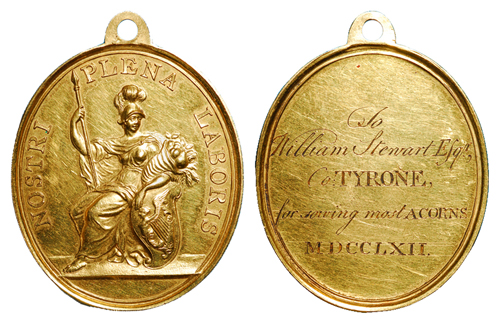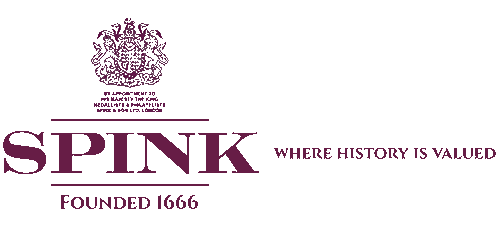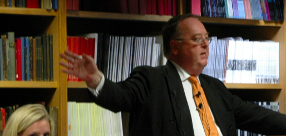
Auction: 7030 - Ancient, English & Foreign Coins & Comm Medals
Lot: 466
Ireland, Royal Dublin Society, Gold Medal, 23.84g, oval, 42mm x 37mm, 1762, attributed to James Brush, awarded to William Stewart Esq of Co. Tyrone, for growing oak trees; Minerva seated left with head turned to right, wearing plumed helmet, holding spear in left hand, right arm holding cornucopia with fruits, lower arm resting on shield inscribed with Irish harp, nostri plena laboris around, rev. engraved award inscription to william stewart esq, co: tyrone, for sowing most acorns mdcclxii., with loop for suspension (see AEJ Went, Scientific Proceedings of the Royal Dublin Society, series B, Vol 3, No.13, p. 165-190, Medal no.1-ill. Plate 1a),
extremely fine, a very rare example of an eighteenth century Irish agricultural improvement prize medal in gold Estimate £ 700-800 The Dublin Society was founded in 1731, by members of the Dublin Philosophical Society for ´improving husbandry, manufactures and other useful arts.´ It became The Royal Dublin Society in 1820 when George IV became patron. The first recorded issue of prize medals by the Society was on 4 June 1761, when it was decided to offer a gold medal ´to the person who shall produce certificates of the most oaks growing from seed sown in not less than two acres and not less than a barrel of good sound acorns to an acre before 4 June 1761´. On 16 July 1761, it was ordered that the reverse of all medals given by the Society should ´be a plain surface on which the name of the person, date and occasion of giving the medal shall be engraved at the expense of the Society.´ No record survives of who designed the medal, but it has been attributed to James Brush, who was enrolled as a quarter brother of the Goldsmiths´ Corporation in Dublin in 1771. He is also known for two Orange Society medals and Collooney Medal of 1798. The first award was made in July 1761 to Benjamin and Joseph Houghton. The records for 1762-1764 have been lost and after 1761, the next recorded award was made in April 1764 to John Darley of Newry, Co. Down. The example offered here is therefore among the earliest, possibly the second awarded by the Society. Went noted three Royal Dublin Society medals of this type in gold: one, awarded for growing saffron dated 1766, owned by the Royal Dublin Society; a second, for reclaiming bog, dated 1765, in the National Museum, Dublin. A third example, dated 1773, not awarded for agricultural improvement, was sold at Sothebys in July 1929 (Panter Collection), lot 153, for £7-10-0 (bought by Spink). This newly discovered example pre-dates these and is the only one known for growing oaks, making this a rare and important Irish Agricultural improvement medal. Wiliam Stewart was one of Ireland´s most dedicated 18th century social and agricultural improvers. The Great Grandson of a Scottish settler of 1619 he inherited the Killymoon Estate in 1726 and appears to have been inspired to modernise his property. By 1740 he had rebuilt Cookstown and in 1765 piped water was installed and a weir built to provide power for its linen mills. He was a Member of Parliament for 21 years and raised a corps of artillery militia in 1779 . He is recorded as a founder member of the Dublin Society This medal has been in the Stewart family since it was awarded in 1762.
Sold for
£2,600




